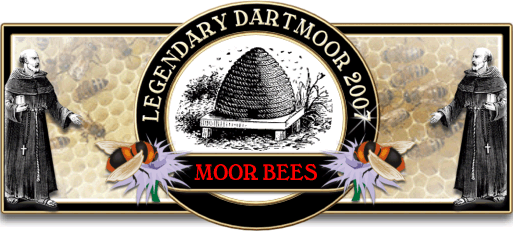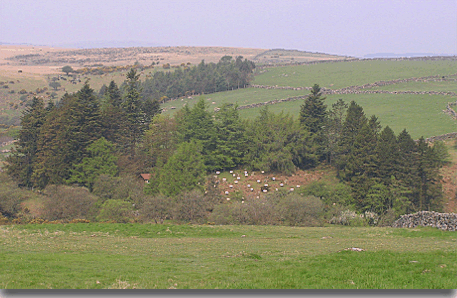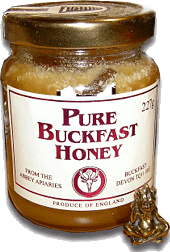
Walk up amongst the heather on a hot summer’s day and the moor will literally buzz with the noise of bees busily collecting pollen. With such an abundance it is hardly surprising that Dartmoor folk fully utilised this resource and that the bee has found itself firmly embedded in tradition and folklore.
The earliest mention of bee keeping in Devon is in the Domesday book. Under the lands held by Walter of Douai is a place called SUTREWORDE which is thought to be modern-day Lustleigh, Domesday states that there are “5 beekeepers who pay 7 sesters of honey.” A sester was an ‘variable’ dry measure and in the case of honey is thought to be 32ozs. In the 16th century, William Harrison describes Devon honey as “Our honie also taken is reputed to be the best, because it is harder, better wrought, and clenlier vesselled.” Right up until the 18th century honey was the main ‘sweetener’ as sugar was so expensive. Honey would also be used to make mead which as a drink dates back centuries, it is said that the word ‘honeymoon’ at one time referred to the custom whereby the father of the bridge had to provide enough mead for a month long celebration of the marriage. Metheglin was also a popular drink made by adding herbs and spices to mead, and was renown for its potent strength. In addition to honey the bees also provided wax which was used for candle-making and wood polish.
Many of the Dartmoor farms still have old granite bee boles in situ, this was where the bee skep or hives were kept to shelter them from the rain. The skeps would have been made of either plaited straw or wood. It was not unknown for moorfolk to catch wild swarms and domesticate them for ‘home use’. Cecil Torr in his book, ‘Small Talk at Wreyland’ (1970, pp. 25 – 27) devotes a disproportionate number of pages to bees, especially swarming. At Wreyland it was the practice to go out with bells, gongs and pans when a swarm of bees was spotted. The theory was that by making a lot of noise it would encourage the bees to pitch in the garden as opposed to flying over. When they did the Wreyland folk would, “gather some balm and cut down some halse boughs (hazel)”, then sugar would be put in the bottom of the hive and rubbed in with the balm thus creating a syrup. Usually the swarm would pitch in a tree and when this happened they would be shaken down into the upturned hive beneath. Once done the hive was turned the right way up and laid on a sheet, this would then be covered with the hazel branches. At nightfall the hive would then be taken and covered with the straw skep, this would then be placed on a small table or in a bee bole.
Torr also relates an occasion when a swarm of bees settled in a post-box near Lustleigh Cleave, every time a letter was posted out would come an angry squadron of bees. The poor old postman didn’t fair any better when he opened the box to collect the mail so a notice was placed on the box saying, “ware bees”. It took the usual course of bureaucracy in which written permission from the postal superintendent at Newton Abbot had to be obtained before the bees could be evicted. The ‘bee man’ was called and the box was emptied by him literally grabbing handfuls of bees and taking them out. Torr also relates how at one of his farms a bedroom ceiling began to sag. Thinking this was due to rain coming through the thatch the bulge was investigated and turned out to be caused by the sheer weight of honey that was being produced by a colony of bees in the roof. If any animal should fall into the hands of the Lord of the Manor the true owners had 12 months to prove ownership otherwise they became his property. In the case of cattle, sheep and ponies proving ownership was not usually a problem, however a swarm of bees was another matter and it usually meant that the Lord got to keep the bees, In 1484 such a case occurred at Wreyland when a swarm pitched on the manor land at Wilmead. The Court Rolls of the time valued these bees at twelve pence which today would be worth about £20. There is also evidence of bee-keeping in a few Dartmoor place-names, for instance there is Beehive Combe and Beesleigh Combe
It was always thought that if somebody dreamt that they were stung by a bee it was an omen that you were going to lose a sweetheart or a friend. Conversely if in your dreams you saw a swarm of bees this signified that you would be highly respected and very wise. There was/is a great deal of superstition regarding a colony or hive of bees, for example, following a death in the family it was vital that the bees were told. This would involve tapping each hive with the key of the front door and then say, “master is dead,” or in the case of a female, “missus is dead.” The bees then had to show signs of mourning and to this end a scrap of black cloth was placed on top of each hive. Similarly, any important event in the family had to be related to the bees as failure to do so would result in the eventual death of the colony. Bees were also used to predict weather patterns, for example if bees were seen in February it meant that the following day would be wet and windy. If anybody saw a swarm of bees they could, depending on the month, predict many things: “A swarm of bees in May is worth a load of hay,” “A swarm of bees in June is worth a silver spoon,” and “A swarm of bees in July is not worth a fly.” A slightly different version from the Sourton area is; “A swarm of bees in may, is worth a guinea that very day.” Nobody should ever move a hive of bees without giving them prior warning and under no circumstance should they be moved on Good Friday, failure to comply with both will mean certain death of the colony. There was also a belief that if a swarm of bees surrounded a woman she would not be stung if she was a virgin. A Christmas tradition is that on old Christmas eve (January 5th) at midnight the bees would all sing in the hive to mark the birth of Jesus. There is one version that considers the bees actual hum the ‘One Hundredth Psalm’.

A Buckfast Bee Station on Dartmoor – May 2006
The most famous bee keeper on Dartmoor must have been Brother Adam of Buckfast Abbey. In his book he notes (p.5) that there are bee boles in an ancient wall at the abbey that certainly pre-date the dissolution of 1539. It is known that after the re-foundation of the monastery in 1882 a colony of bees was established at the abbey. In the early 1900’s thirty out of forty six bee colonies were wiped out by a disease called acarine and it was shortly after this that Brother Adam began re-establishing the colonies with a stronger stain of bee. Brother Adam began bee keeping in 1915 when he was appointed assistant to Brother Columban. In 1919 Brother Adam was given sole charge of bee-keeping at the abbey. The Buckfast strain of bee has evolved from a cross between the old native English bee and the leather-coloured Italian bee. On of the main qualities of this strain is its disinclination to swarm along with excellent honey-gathering ability. At Buckfast the hives would be checked every ten days during the swarming season and should there be any sign that the bees are preparing to swarm the queen-cells are removed. If on the next inspection new queen-cells are evident this is taken as a sign that the bees are definitely going to swarm. In this case the queen bee is removed and all the queen-cells removed, then on the next inspection any new queen-cells are removed and a new fertile queen introduced. The very fact that the hive was left with no queen for ten days ensures that they won’t swarm for the rest of the season. On the other hand in 1990 they were described by an Irish beekeeper in a radio broadcast as being; “baleful, unsociable souls, who become enraged when the weather turns foul or when the honey-flow congeals to a halt.” Needless to say the Buckfast bees are a valuable target for thieves and over the years have been the target of many a theft, between 1977 and 1979 Brother Adam estimated he had lost 30 frames of bees and in the 1979 incident he lost the only the only Omani bee that was in Britain, this had been on lone from Durham University. In 1980 eight irreplaceable bees went missing and it was thought the culprit/s responsible were other bee keepers.
The Buckfast honey crop is obtained from the Dartmoor heather. To this end the bees are moved up onto the moor on or about the 28th of July. This is to coincide with the main flower season of the ling which is between mid August to early September. After this date the bees are returned to the Abbey apiaries. At one time the hives were carried up onto the moor in wheelbarrows but in later years the convenience of a motor vehicle was adopted. In the July of 1931 a van containing several hives of Buckfast Abbey was transporting them along the Hexworthy road. When suddenly it was noticed that they were on fire, unfortunately by this time the fire had got a strong hold made worse by being fanned by a strong breeze which resulted in the van being a twisted wreck and all the hives and their bees destroyed. The operation takes about 10 days and once on the moor the hives would be set out in south facing rows. Today the abbey has around 240 hives which are dispersed amongst 9 apiaries which produce around 4 tons of honey per year. There is also a breeding station on the moor which due its seclusion conserves the purity of the Buckfast bee lines. Any surplus queen bees are sold and colonies of the bee have now been established all around the world.

 Legendary Dartmoor The many aspects past and present of Dartmoor
Legendary Dartmoor The many aspects past and present of Dartmoor
